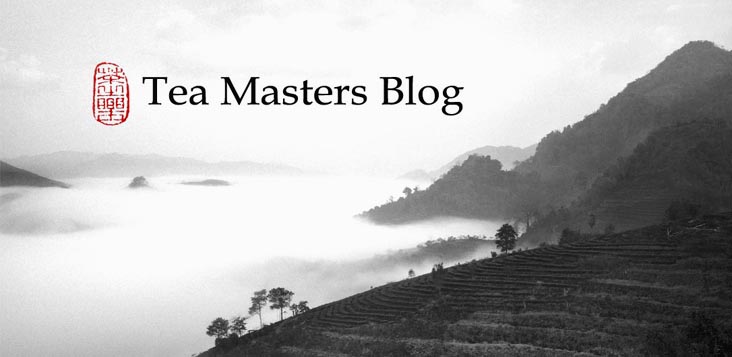
When the weather is hot and the sun shines with all its strength, it's often time for a green tea or a light mountain Oolong. Teaparker had another idea: a brew of 7638, the 33 years old ripe brick from Kunming Factory (3) using leaves recipe number 8 (not necessarily the grade of the leaves). (Note: they inverted the number for factory and leaves in 1976 for this brick.)
Amazingly, it works! The tea is so soft, pure and mellow, that it managed to cool us by its calm. It has the smell of ripe puerh, but the taste is so soft, almost non-existant that we didn't rinse it. I contrast this to most recent ripe puerhs that I've tested recently. Their first 2 or 3 brews are best thrown away, because so unpleasant in the mouth and throat. But with this old brick, it's perfect with the first sip. We did notice some white oily shine on some dry leaves, which means that this brick is still evolving. Time has made it better, but I don't think that time alone is responsible for the perfection of this ripe puerh. First, in 1976, the leaves used were still mostly wild or old arbor. Second, the ripening process was done well. This isn't always the case with ripe puerh, though...
Teaparker told us so pretty scary stories on how some make ripe puerh:
- Dig a hole in the ground, fill it with puerh leaves, cover with a plastic blanket, wait 4 weeks approximately. Et voilà! It's magic! (This method brings a very 'earthy' taste to ripe puerh!)
- Put the puerh leaves in an exposed cabin with thin walls in the countryside (like where a farmer keeps his tools). Sun and humidity from the fields next and under the cabin will do the rest! (This method also involves pesticides to keep insects away from the leaves!)
The right way to ripen puerh is in a
clean building, with concrete floor. Ideally, the leaves would be put on bamboo mats. Then, only pure local mineral water would be used to water them, and the ripening process would last around 7 weeks with regular checks.

Now it's time to see if ripe puerh is also a good choice at my sunny tea spot! I grab my oldest cooked puerh, the 1990 '9016' Fuhai Tuo Cha.
I choose a Chaozhou teapot and 3 small old porcelain cups.

The porous teapot will help soften the tea and the thin cups aim to catch its finesse. The natural colors of the background echo to the ripe puerh, while the refinement on the Cha Bu suggest that even ripe puerh can become a wonderful tea.
After rinsing the tea once, I proceed with my tasting. Of course, it can't measure up to the 7638 brick, but it remains one of the nicest ripe puerhs I could find. Sweet and calm. It's a different way to cool down (than young green tea), but it works!

 Back in France, I have the opportunity to make tea with my mother's porcelain teaware. She bought it in the late 1960s from the Herend manufactory (est. 1826 in Hungary). It's a very classical aristocratic style, hand painted in great detail. It's the kind of teaware you'd expect to drink with a princess or a duchess. No wonder Herend would devote a section of their site to their Famous Customers.
Back in France, I have the opportunity to make tea with my mother's porcelain teaware. She bought it in the late 1960s from the Herend manufactory (est. 1826 in Hungary). It's a very classical aristocratic style, hand painted in great detail. It's the kind of teaware you'd expect to drink with a princess or a duchess. No wonder Herend would devote a section of their site to their Famous Customers.
 Usually, this set stays locked in a safe place and is seldom used. A family tea party for my return gave me the right opportunity to take it out. I noticed that the teapot was stained inside, so I cleaned it beforehand. Then, I chose a top red tea from Taiwan to go along with this set. Red (or black in Europe) tea is the best fit for this teaware.
Usually, this set stays locked in a safe place and is seldom used. A family tea party for my return gave me the right opportunity to take it out. I noticed that the teapot was stained inside, so I cleaned it beforehand. Then, I chose a top red tea from Taiwan to go along with this set. Red (or black in Europe) tea is the best fit for this teaware. 



































